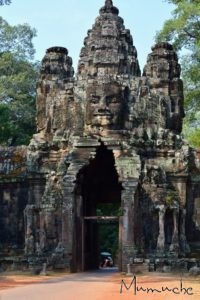Cambodia was on top of my bucket list and I have been luncky enough, this year, to realise this dream.
After the very dark years of the Vietnam war and Pol Pot’s genocide, the country is only emerging and opening to the rest of the world.
Mixing with the locals will, of course, bring your experience with this country to another level and is definitely worth doing.
ANGKOR WAT
My first visit was to Angkor Wat.
I booked a tuk-tuk with a guide, Bora-Pheng, for three days to visit Angkor and the major temples. Bora-Pheng has been a real gem and his knowledge of the history is phenomenal. I have read a lot about guides whose command of English is poor; therefore, it is advisable to get in touch with other visitors to check that you will get the best of your guide whilst in Cambodia.
You will find a lot of information about guides with tuk-tuk on Facebook and Tripadvisor.
My dream was to watch the sun set over the temple.
Unfortunately, that day, the sun decided not to show up (at least, not at 6am).
However, seeing the temple coming to life was an amazing experience.
Angkor Wat means “Royal Temple City” and in Khmer “the pagoda city”.
It is also the symbol of Cambodia, which can be found on the national flag.
It was built during the reign of Suryavarman II.
It was originally an Hindu temple dedicated to Vishnu, but became a Buddhist one in the 16th century.
An army of 300,000 workers and 6,000 elephants is considered to have been involved in its construction.
The temple was abandoned in the 16th century, the reasons being still unknown today. Buried for centuries, it is Henri Mouhot, a French geographer, who discovered it the first to discover in 1860.
It was built on the principle of temples-mountains, that is to say as a symbolic representation of Mount Meru, place of residence of the gods.
The high walls represent the mountains, the moats represent the ocean and the summit of the temple, the residence of the gods.
Since 1992, it is registered as a UNESCO World Heritage.
TA PROHM
 Ta Prohm is also called the Tom Raider temple.
Ta Prohm is also called the Tom Raider temple.
The temple was built around 1186.
With the fall of the Khmer Empire in the 15th century, the temples were abandoned and forgotten.
400 years later, European explorers discovered them.
The appearance it has today is very similar to the day it was discovered as it was decided to leave Ta Prohm as it was.
The only changes that have been made were to avoid the collapse of the site.
Before its fall, Ta Prohm was an important monastery and a Buddhist university.
 King Jayavarman VII built the site in honor of his mother.
King Jayavarman VII built the site in honor of his mother.
An inscription in sanskrit gives an idea of its importance: nearly 80,000 people were in charge of its maintenance.
It contained more than 500 kilos of gold, 35 diamonds and several thousand precious stones.
It is comprised of 39 towers, which makes it is one of the largest temples of the Angkor complex.
BAYON TEMPLE
 Bayon is the central temple of the ancient city of Angkor Thom, the capital of Khmer sovereings in the early 13th century.
Bayon is the central temple of the ancient city of Angkor Thom, the capital of Khmer sovereings in the early 13th century.
It is composed of 54 towers, each consisting of 4 huge carved faces. Each of the four faces is four meters high and oriented towards the four cardinal points. The faces all have the same strange smile and closed eyes. The creation of a mysterious and serene face represents a state of omniscience, inner peace and perhaps a state of Nirvana.

The last state temple was built around the beginning of the 13th century, by King Jayavarman VII, who was at the height of his reign.
Around 1350, at the time of King Jayavarman VIII (1243-1295), the temple was converted to hinduism, the official religion of the Khmers at this time.

The faces on the towers arouse a lot of supposition.
Archaeologists claimed that they are inspired by the faces of Lokeshvara and Bodhisattva Avalokiteshvara or Brahma. These Buddhist deities are known for their benevolence projected outward to the four cardinal points.
Other scholars thought they were the depiction of King Jayavarman VII.
These constructions reflect the omnipresence of the religious deities within the ancestral city of Angkor.
In 1992, Bayon was listed on the UNESCO World Heritage List.
To be continued…



















